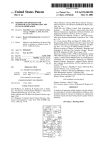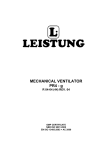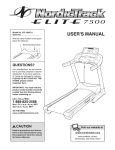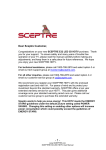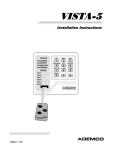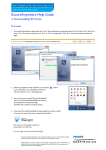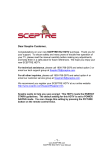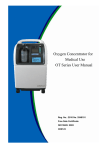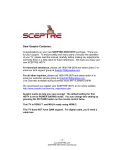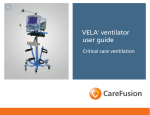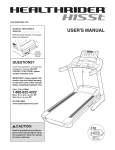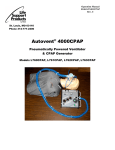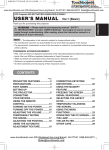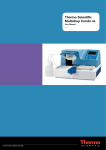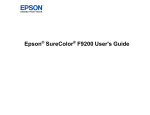Download PLV 100 User Manual
Transcript
TABLE OF CONTENTS ■ Sections 64 Respironics® PLV-100 Patient Manual, p/n 35555 1 Preface 2 Introduction 3 You and Your Ventilator 4 Do’s and Don’ts 5 The Front of the Ventilator 6 The Back of the Ventilator 7 Setting-Up & Checking the Ventilator 8 Alarms 9 Maintenance and Cleaning 10 Power 11 Troubleshooting Guide 12 Humidifiers 13 Important Words to Know 14 Daily Ventilator Checklist 15 Notes Respironics® PLV-100 Patient Manual, p/n 35555 1 Warnings and Cautions ▼ Throughout this manual the following definitions apply: • Warning: A condition that may cause injury to a patient or operator if instructions are not followed. • Caution: A condition that may cause damage or shorten the service life of the PLV-100. ▲ Personnel using and operating the PLV-100 must become familiar with this instruction manual before initial setup and use. Warnings ▲ Equipment that does not function correctly or alerts the user to a potential problem, (by sounding an alarm), must not be used until the problem is corrected. ▲ Do not use the PLV-100 in the presence of flammable anesthetics. ▲ Do not remove any covers or panels. Refer all servicing to authorized service personnel. ▲ To avoid the entrainment of battery gases into the intake ports on the rear panel do not operate the PLV-100 directly above a battery. ▲ Due to the wide variety of disposable tubing, the user must be certain the connection to the patient air outlet fits properly. Cautions ▲ Do not place containers of liquids on the ventilator. Do not spill liquids on the ventilator. ▲ The PLV-100 must be periodically checked and maintained to ensure proper operation. ▲ Do not use the PLV-100 to charge a deeply discharged external battery. Thank you for using the Respironics PLV-100 ▲ Connect the PLV-100 only to a grounded outlet. ▲ If either front panel circuit breaker trips, reset by pushing the round circuit breaker knob in until it “clicks” back into position. If the breakers continue to trip after resetting, return the ventilator to an authorized service personnel for repair. ▲ Do not position the PLV-100 as to block the air intake ports located on the rear panel. ▲ Performance may be affected at temperatures below -5°C (23°F) and above 41°C (106°F). ▲ Do not disconnect the external battery while the unit is operating under load. This may cause the unit to repeat the diagnostic start-up cycle. ▲ Do not operate the unit on the internal batteries in place of external batteries. ▲ To decrease the chance of depleting the wheelchair battery, do not use the battery as the external power source for the PLV-100. ▲ Storage of the unit with a partially discharged internal battery severely decreases the battery life. Always store the unit with the power plug connected to AC voltage, or only after fully charging the internal battery from AC voltage. ▲ Frequent and/or prolonged use of the unit on internal battery shortens the battery life. This requires close monitoring of the battery strength and may require battery replacement sooner than the normal maintenance interval. ▲ Caution: Federal law restricts this device to sale by or on the order of a physician. 2 Respironics® PLV-100 Patient Manual, p/n 35555 Respironics® PLV-100 Patient Manual, p/n 35555 63 SECTION 15: NOTES SECTION 1: PREFACE Important reminders from your home care team: _______________________________________________________________________________ Respironics wishes to thank Karen Glenn, RRT, and Barry Make, MD, of the National Center for Home Mechanical Ventilation for their assistance in the writing of this manual. Their professional expertise was invaluable in the organization and presentation of this material. We know that you will find this information helpful in your use of the PLV®-100 ventilator. _______________________________________________________________________________ _______________________________________________________________________________ _______________________________________________________________________________ Users of the manual are also referred to the PLV-100 Operating Manual for additional information on the operation of this ventilator. _______________________________________________________________________________ _______________________________________________________________________________ _______________________________________________________________________________ _______________________________________________________________________________ Questions for your home care team: _______________________________________________________________________________ _______________________________________________________________________________ _______________________________________________________________________________ _______________________________________________________________________________ _______________________________________________________________________________ _______________________________________________________________________________ _______________________________________________________________________________ _______________________________________________________________________________ _______________________________________________________________________________ _______________________________________________________________________________ _______________________________________________________________________________ 62 Respironics® PLV-100 Patient Manual, p/n 35555 Respironics® PLV-100 Patient Manual, p/n 35555 3 SECTION 2: INTRODUCTION SECTION 14: DAILY VENTILATOR CHECKLIST Your new ventilator is the PLV-100 made by Respironics. Your health care professional (doctor, nurse or therapist) has ordered this ventilator to meet your needs. This manual is designed to help you use and care for the PLV-100. Please read this manual and become familiar with the PLV-100 before using the ventilator. Before using the ventilator for the first time, make sure your health care professional (doctor, nurse or therapist) demonstrates how to use the PLV-100. Ventilator Settings Checklist Date Settings last changed Mode: ___________ ___________ Tidal volume: ___________ Rate: ___________ The PLV-100 is controlled by a small computer chip and is electrically powered. It can be plugged into a wall outlet or connected to a car-type battery. It also has an internal battery for short-term emergency power. Inspiratory Flow: ___________ Sensitivity Points to: ___________ The PLV-100 is designed for long term use in the home. Airway Pressure Limit Because of its small and lightweight design, the PLV-100 is portable. However, check with your home care company before traveling with the ventilator. For more help call your home care company or Respironics. 4 Respironics® PLV-100 Patient Manual, p/n 35555 points to: ___________ Low Pressure Alarm Set points to: ___________ Usual breath pressure: ___________ Humidifier Setting ___________ Air Temperature ___________ Oxygen % or Flow ___________ PLV-100 Serial Number: ___________ Date PLV-100 in use: ___________ PLV-100 hours at start: ___________ Respironics® PLV-100 Patient Manual, p/n 35555 61 SECTION 14: DAILY VENTILATOR CHECKLIST My Doctor Name: _______________________________ Address: _____________________________ ____________________________________ Phone _______________________________ My Home Care Company SECTION 3: YOU AND YOUR VENTILATOR Your body needs to move fresh air into and out of the lungs. Muscles help pump the air into the lungs. As fresh air moves through the nose and mouth it is warmed, filtered, and moisturized. The air then travels through the windpipe and into the lungs. The lungs are the sight where the oxygen from the air is absorbed by the body and carbon dioxide is released. Your doctor has ordered the PLV-100 ventilator to help pump air into your lungs. This ventilator is adjustable to meet your personal needs. Because your doctor knows how much air you need from the ventilator, the ventilator is set to: Name: _______________________________ • Pump the right amount of air into your lungs with each breath, (called the tidal volume). Address: _____________________________ • Deliver the right number of breaths each minute, (called the breathing rate). ____________________________________ Phone: _______________________________ If power failure: Power Company Name: _______________________________ • Move air into your lungs at the speed you need, (called inspiratory flow). The PLV-100 ventilator provides all of your breaths or just some of your breaths. A machine breath is when the ventilator delivers a breath. When you take a breath on your own, this is called a patient breath. Your ventilator can even be set to deliver a breath when you start to take a breath on your own – called an assisted breath. Phone: _______________________________ Patient Name: _________________________ Address: _____________________________ 60 Respironics® PLV-100 Patient Manual, p/n 35555 Respironics® PLV-100 Patient Manual, p/n 35555 5 SECTION 4: DO'S AND DON'TS ■ Please Do! • Read this manual and learn how to operate the PLV100 before using it. • Use the PLV-100 only at the settings prescribed. If you are unsure of the settings, contact your home care company or doctor. Tidal Volume Size of the breath the ventilator delivers. This is measured in liters (1 liter= about 1 quart). Inspiratory Flow Speed the ventilator delivers a breath. This is measured in liters per minute (abbreviated LPM). • If there is a problem with the PLV-100, FIRST MAKE SURE THAT YOU ARE ABLE TO BREATHE – use a backup ventilator or manual resuscitator if necessary – then call your home care company immediately. Patient Rate Number of breaths the machine is set to deliver each minute. It is measured in breaths per minute (abbreviated BPM). • If the circuit breaker on the front of the ventilator trips, reset it once. If it trips again, use a backup ventilator or manual resuscitator and call your home care company immediately. Machine Breath Breath given by the machine at the set tidal volume, (size of the breath), and the set inspiratory flow rate, (rate the breath is delivered). • Use the Daily Ventilator Checklist each day, (located in Section 14 at the back of this manual), to make sure that the ventilator is working right. • Connect the PLV-100 to a 3-prong, grounded outlet when wall power is used. Check with your home care company or power company if your are unsure about the outlets in your home. • Replace the fuse on the back of the ventilator, (when needed), with a 5 amp slow blow fuse, type 3AG. 6 SECTION 13: IMPORTANT WORDS TO KNOW Respironics® PLV-100 Patient Manual, p/n 35555 Assisted Breath Breath given by the ventilator at the set tidal volume and inspiratory flow rate that the patient starts by beginning to breathe in. This kind of breath can only happen in Assist/Control Mode and SIMV Mode. Patient Breath Breath taken on your own through the ventilator tubing. You can take the breath at the speed and size you want. This kind of breath is only possible in the SIMV mode. Respironics® PLV-100 Patient Manual, p/n 35555 59 SECTION 12: HUMIDIFIERS LIFECARE® Artificial Nose SECTION 4: DO'S AND DON'TS The Artificial Nose Humidifier The artificial nose is a short piece of tubing. When you breathe out, the moisture in this air is trapped inside the tubing. The next breath you take goes through the tubing and picks up the moisture. This process happens with each breath. General important points: • Artificial noses are very easy to use when you are away from home because they do not need refilling and cannot spill. • Phlegm can get trapped in the artificial nose and block the air from going through it. • They must be changed on a regular schedule, usually more often than the ventilator tubing. • They do not give as much humidity as the heated humidifier, and some individuals who have tracheostomy tubes may not get enough humidity. 58 Respironics® PLV-100 Patient Manual, p/n 35555 ■ Please Don't! • Don't use the PLV-100 until a health care professional, (your doctor, nurse or respiratory therapist), says that you are ready to operate it. • Don't use any equipment if it does not work right or continues to alarm. • Don't set containers of liquid on or near the PLV-100. • Don't block the intake air ports on the back of the ventilator. • Don't use the PLV-100 at temperatures below 23°F (-5°C) and above 106°F (41°C). • Don't open the case of the PLV-100. All repairs must be done by specially trained service people. Respironics® PLV-100 Patient Manual, p/n 35555 7 SECTION 5: THE FRONT OF THE VENTILATOR SECTION 12: HUMIDIFIERS When you breathe on your own, air passes through your nose or mouth where it is warmed and moisture is added. This moisture is very important for your lungs because it helps the lungs fight infection and keeps your phlegm thin. If you use your ventilator with a tube in your throat (tracheostomy tube), you probably have a humidifier, because the air does not go through your nose or mouth. Even if you use your ventilator with a nasal mask or mouthpiece you may want to use a humidifier because it makes breathing more comfortable. Basically, there are two kinds of humidifiers. One is an electrically heated container that holds water. The other is a small device that catches the moisture in air you exhale and adds it the next breath you take in, (usually called an artificial nose). There are many different brands of both humidifiers available. Always follow the manufacturer’s directions for your specific humidifier. Typical Heat and Water Humidifier A breath from the ventilator goes through a piece of ribbed tubing and into the humidifier. The air is warmed and picks up moisture and goes through the rest of the ribbed tubing to you. General important points: • These humidifiers give the most moisture. • These humidifiers need to be plugged into a wall outlet. • Since these humidifiers use water, you need to add water to the container several times each day. • These humidifiers must be changed or cleaned on a regular schedule along with the ventilator tubing. • NEVER dump water that has collected in the ribbed tubing back in the humidifier. This can lead to a lung infection. 8 Respironics® PLV-100 Patient Manual, p/n 35555 Respironics® PLV-100 Patient Manual, p/n 35555 57 SECTION 11: TROUBLESHOOTING GUIDE Symptom Ventilator is working and an alarm sounds once briefly for about 3 seconds. 120 VAC light is flashing. SECTION 5: THE FRONT OF THE VENTILATOR Probable Cause Corrective Action Switch to Battery Alert sounding. 1. Check the battery voltage and make sure the battery has enough power. ■ Mode 1. Mode 3. Check the house fuse/circuit breaker. 56 Battery Cable connections are reversed on the battery. Reconnect Battery Cable with the WHITE cable to the POSITIVE (+) battery terminal, and the BLACK cable to the NEGATIVE (–) terminal. External Battery power is in use. An alarm sounds and the External Battery light is flashing. Low External Battery voltage 1. Plug the ventilator into a wall outlet to power the ventilator. Increase Inspiratory Flow light is flashing after changing Rate, Tidal Volume or Inspiratory Flow Rate. The numbers in the Inspiratory Flow and Rate windows have changed and are flashing. Inspiratory Flow Rate set too low for the set Rate and Tidal Volume. 2. Recharge the external battery. Respironics® PLV-100 Patient Manual, p/n 35555 Control: The ventilator delivers all breaths at the size and rate set on the machine, (machine breaths). More than the allotted breaths cannot be taken. Assist/Control: The ventilator delivers all breaths at the size set on the machine, (machine breaths). The rate set on the machine is the minimum number of breaths received. The ventilator delivers more breaths when you begin to take a breath. When the ventilator senses an attempt to breathe in, it delivers an assisted breath. 2. Check that the power cord is securely plugged into back of ventilator and the wall outlet. External Battery cable has just been connected and an alarm sounds. Your doctor has decided which one of these is right for you to use: SIMV (Synchronized Intermittent Mandatory Ventilation): The ventilator delivers machine breaths at the size and rate set on the machine. Additional breaths, that are not machine breaths, (patient breaths), may be taken by breathing normally. When the ventilator senses the beginning of a breath just before the ventilator delivers a machine breath, it delivers an assisted breath. To make it easier to breathe, without machine assistance, connect an H-valve (SIMV valve) in the patient circuit. 2. Tidal Volume Knob and Window Sets and displays the size, (tidal volume), of the machine breaths in liters, (one liter = about 1 quart). Readjust the Inspiratory Flow Rate knob. *Refer to page 40 for more information. Respironics® PLV-100 Patient Manual, p/n 35555 9 SECTION 5: THE FRONT OF THE VENTILATOR SECTION 11: TROUBLESHOOTING GUIDE Symptom Ventilator passed the start-up check and is operating. A continuous alarm sounds and the 15 Sec. Delay light is on all the time. Probable Cause Low Pressure Alarm Corrective Action 1. Check the connection of tubing to the patient. 2. Check trach or mask for air leaking around it. 3. Check entire circuit, including the exhalation valve, for loose connections, disconnections or holes. Re-secure connections or change circuit if damaged. 4. Check medium (PAP) tubing for water or mucous. Replace tubing if dirty. 5. Check that the Low Pressure Alarm is set correctly. Ventilator is working and an alarm sounds only during the machine or assisted breaths. High Pressure Alarm 1. You are speaking or coughing. 2. You need suctioning. 3. Water has built up in the large ribbed tubing and needs to be emptied. 4. The large ribbed tubing is pinched. Check tubing for damage after freeing. 5. Check that the Airway Pressure Limit is set correctly. 10 Respironics® PLV-100 Patient Manual, p/n 35555 Respironics® PLV-100 Patient Manual, p/n 35555 55 SECTION 11: TROUBLESHOOTING GUIDE SECTION 5: THE FRONT OF THE VENTILATOR WARNING: Whenever there is an alarm, check that you can breathe; use a back-up ventilator or manual resuscitator if needed, unless you find and fix the problem right away. Symptom Probable Cause Ventilator switched “ON” and does not operate. A continuous alarm sounds. 1. There is no power to the unit. 1. Plug into wall outlet to power ventilator and charge batteries. 2. Circuit breaker tripped. 2. Push the circuit breakers back in. If the circuit breaker trip again, do not use this ventilator, and call your home care company. 3. Shipping fuse problem. 54 Corrective Action “1.0” or “2.0” is displayed in Tidal Volume window. Ventilator does not operate and “Fast Beep” alarm sounds. Ventilator computer problem. The ventilator passed the start-up check and begins operation. A 3second alarm sounds and Internal Battery light is flashing. Low Internal Battery voltage Respironics® PLV-100 Patient Manual, p/n 35555 3. Check that the shipping fuse is in place, or replace. DO NOT USE THIS UNIT. Call your home care company to service your ventilator. 1. Connect ventilator to a wall outlet or an external battery at once to keep ventilator working. ■ Mode (Continued) 3. Rate Knob and Window This knob sets the number of machine breaths delivered each minute, (counted as BPM = breaths per minute). Depending on the ventilator Mode used, the window shows: a. Control Mode: The number of machine breaths is shown. b. Assist/Control Mode: The total number of machine breaths and assisted breaths are shown. c. SIMV Mode: The total number of machine breaths, assisted breaths and patient breaths are shown. 4. I:E Ratio Window Shows the ratio of length of time used to breathe in (inspiration) compared to the length of time used to breathe out (expiration) during machine breaths. There are 2 numbers in this window separated by a colon (for example, 1:2). 5. Inspiratory Flow Rate Knob and Window Sets and shows the Inspiratory Flow Rate, (that is how fast the ventilator delivers the breath). 6. Increase Inspiratory Flow Light This light turns on when the machine’s settings are changed to values that it cannot accommodate. See page 43. 2. Recharge Internal Battery. Respironics® PLV-100 Patient Manual, p/n 35555 11 SECTION 5: THE FRONT OF THE VENTILATOR SECTION 10: POWER ■ Explanation of Power Sources Continued To check the Internal Battery voltage (continued): 6. Read the voltage level in the Inspiratory Flow Rate window; this is not the amount of time left in the battery charge. If the voltage is less than 10 volts, recharge the Internal Battery. 7. Release the Battery Voltage Test Switch. 8. Plug the unit into the wall outlet and/or connect the external battery to the unit. 12 Respironics® PLV-100 Patient Manual, p/n 35555 Respironics® PLV-100 Patient Manual, p/n 35555 53 SECTION 10: POWER ■ Explanation of Power Sources Continued SECTION 5: THE FRONT OF THE VENTILATOR Internal Battery 12 Volt DC Power: The PLV-100 has a built-in internal battery for a short term power source. A fully charged battery powers the PLV-100 for up to one hour, depending upon the ventilator settings. An audible alarm sounds and the Internal Battery light flashes when the internal battery voltage is low. The internal battery slowly recharges whenever the ventilator is connected to a wall outlet — even when the Power Switch is off. To check the Internal Battery voltage: 1. Unplug the Power Cord from the wall outlet. A 3-second alarm sounds warning that the power source the ventilator is using has changed. ■ Pressure 7. Sensitivity Knob In Assist/Control Mode, this controls the amount of breathing effort needed to start an assisted breath. In SIMV Mode, this controls the amount of breathing effort needed to count patient breaths or assisted breaths. 8. Assist/ Spontaneous Light This light turns on briefly when: In Assist/Control Mode - when there is an assisted breath. In SIMV Mode - when there is an assisted breath or a patient breath. 2. Disconnect the External Battery. A 3-second alarm sounds to tell you that the power the ventilator is using has changed. The Internal Battery light (gold) turns on. Important: This light does not turn on in the Control Mode. 3. Wait 2-3 minutes. 4. Push the Battery Voltage Test Switch to the "Internal" or up position. 9. Low Pressure Alarm Set Knob This sets the pressure at which the low pressure alarm sounds. This alarm sounds when the ventilator becomes disconnected from the patient. This safety alarm has a 15-second delay. 10. 15 Second Delay Light As part of normal operation, this light turns on after each machine breath and turns off during each machine breath. 5. Hold the switch up until the ventilator delivers a breath. 52 Respironics® PLV-100 Patient Manual, p/n 35555 Respironics® PLV-100 Patient Manual, p/n 35555 13 SECTION 5: THE FRONT OF THE VENTILATOR SECTION 10: POWER ■ Explanation of Power Sources Continued The external battery slowly recharges whenever it is connected to the ventilator that is using the wall outlet for its power source — even when the Power Switch is off. Use a battery charger to recharge an external battery that has been used for a few hours. To check the External Battery voltage: 1. Connect the External Battery to the ventilator. 2. Unplug the wall outlet power cord. A 3-second alarm sounds warning that the power source the ventilator is using has changed. The External Battery light (white) turns on. 3. Wait 2-3 minutes. 4. Push the Read Battery Volts switch to the "External" or down position. 5. Hold the switch down until the machine delivers a breath. 6. Read the battery voltage on the Inspiratory Flow Rate window; this number is not the amount of time left on the battery. If the voltage is less than 10 volts, recharge the External Battery. 7. Release the switch. 8. Plug the unit into the wall outlet. 14 Respironics® PLV-100 Patient Manual, p/n 35555 Respironics® PLV-100 Patient Manual, p/n 35555 51 SECTION 10: POWER ■ Explanation of Power Sources Continued SECTION 5: THE FRONT OF THE VENTILATOR External Battery 12 Volt DC Power: The PLV-100 can be powered by an optional external battery, such as a deep-cycle boat battery. This makes it easier to leave your home. An external battery (when fully charged) lasts for up to 24 hours, depending upon the ventilator settings. An audible alarm sounds and the External Battery light flashes when the external battery is low. ■ Pressure (Continued) 11. Pressure Gauge Displays the pressure in the ventilator tubing in cmH2O, (centimeters of water) . 12. Exhalation Valve Tubing Connector The smallest (1/8") smooth tubing of the ventilator circuit connects to this port. This controls the exhalation valve, (the valve that lets you breathe out). 13. The medium (3/16") tubing from the ventilator circuit connects to this port. Number of breaths and pressure are sensed by the ventilator through this tubing. 2. Connect the WHITE wire of the cable to the POSITIVE (+) battery terminal and the BLACK wire of the cable to the NEGATIVE (-) battery terminal. Assist/PAP (Proximal Airway Pressure) Connector 14. Patient Air Outlet Connector The large ribbed ventilator tubing connects to this port. The ventilator delivers machine and assisted breaths through this tubing. Note: If these are switched when you connect the cable to the PLV-100, an alarm sounds, but the PLV100 is not damaged. 15. Airway Pressure Limit Knob Sets the limit of pressure that can reach the lungs. To Connect the External Battery: 1. Use the Respironics external battery cable from your home care company. Twelve-foot and six-foot cables are available. Your home care company can provide you with a battery and instruct you on how to set it up. 3. Line up the white dot near the External Battery receptacle on the front of the PLV-100 with the dot on the external battery cable connector. 4. Push the cable connector into the ventilator and twist to the right to lock. 50 Respironics® PLV-100 Patient Manual, p/n 35555 Respironics® PLV-100 Patient Manual, p/n 35555 15 SECTION 5: THE FRONT OF THE VENTILATOR SECTION 10: POWER ■ Explanation of Power Sources The PLV-100 automatically selects the best power source available. It looks for power in the following order: 1. Wall Outlet 2. External Battery 3. Internal Battery If the PLV-100 is plugged into a working wall outlet, the wall outlet power is always used. If the ventilator is not plugged into a wall outlet or there is a power loss, the ventilator looks for and use the external battery. The PLV-100 only uses the internal battery if neither the wall outlet nor an external battery can be used. Wall Outlet (120 volt AC power): To use a wall outlet, securely connect the power cord into the Power Cord receptacle on the back of the PLV-100 and plug the other end into a wall outlet. For safety, the wall outlet must be grounded and must have three holes to fit the threepronged plug. The outlet should be checked for safety by your home care company, electric company or electrician before the ventilator is plugged in. This is the only power source that does not need recharging. Note: Whenever possible, leave the PLV-100 plugged into a wall outlet to keep the unit’s batteries fully charged. 16 Respironics® PLV-100 Patient Manual, p/n 35555 Respironics® PLV-100 Patient Manual, p/n 35555 49 SECTION 9: MAINTENANCE AND CLEANING ■ PLV-100 Preventive Maintenance The PLV-100 must have preventive maintenance done at least every 8,000 hours of ventilator use, or once a year whichever occurs first. The PLV-100 has an hour meter that records the number of hours the ventilator is used. The hour meter is located behind the Machine Air Inlet filter located on the back of the ventilator. The hour meter can be seen after the filter is removed. A loaner ventilator may be provided by Respironics or through your home care company during this warranty or contract service. SECTION 5: THE FRONT OF THE VENTILATOR ■ Power 16. Read Battery Volts Switch Whenever the ventilator is powered by a battery, the voltage (charge) left in the battery can be checked. To check the battery, push and hold the switch in the up position when the internal (back-up) battery is in use. Push and hold the switch in the down position when an external battery is in use. The voltage is displayed on the Inspiratory Flow Rate window (5) after the ventilator gives the next breath. Before the ventilator is sent in for maintenance or service, make sure you are able to breathe by using a backup or loaner ventilator. Important: Wait 2-3 minutes after beginning to use the internal or external batteries before checking the voltage. Refer to the Power Section for more information. 17. Power Source Lights 120 VAC (Green light): Lit when power is from a wall outlet. Internal (Gold light): Lit when ventilator is using the internal battery. This light flashes when the internal battery charge is low. Important: The internal battery only supplies enough power for up to one hour of use, depending upon the ventilator settings. This is intended for switching between AC and external battery power only. External (White light): Lit when ventilator is using an optional external battery. This light flashes when the external battery charge is low. 48 Respironics® PLV-100 Patient Manual, p/n 35555 Respironics® PLV-100 Patient Manual, p/n 35555 17 SECTION 5: THE FRONT OF THE VENTILATOR SECTION 9: MAINTENANCE AND CLEANING ■ Cleaning the PLV-100 Clean the outside of the PLV-100 every two weeks, or as often as needed. Use a clean, damp (not wet) cloth and soapy water (dishwashing liquid). ■ Cleaning the PLV-100 Filters The Machine Air Inlet filter and the Patient Air Inlet filter are located on the back of the ventilator. Check both of them twice a week and clean them when they look a little dusty. These filters are cleaned and reused. ■ Filter Cleaning Procedure 1. Unscrew and remove the white plastic covers over both the Patient Air Inlet and Machine Air Inlet. 2. Look to see if the black foam filters are dusty. They need cleaning if they look a little dusty. Check and clean them more often if they look very dusty. 3. Remove the dirty filters and insert clean filters. 4. Screw the white plastic covers over the clean filters. 5. Rinse the dirty filters in warm water. 6. Let the filters air dry before storing in a clean plastic bag in a dust-free area. 7. Replace the filters when they become worn or discolored. 18 Respironics® PLV-100 Patient Manual, p/n 35555 Respironics® PLV-100 Patient Manual, p/n 35555 47 SECTION 9: MAINTENANCE AND CLEANING ■ Cleaning the Tubing Continued 10. Hang the tubing up to dry. 11. Place all other parts on a clean towel to dry; do not wipe dry. 12. WHEN COMPLETELY DRY, check all equipment for signs of wear and damage, and replace as necessary. SECTION 5: THE FRONT OF THE VENTILATOR ■ Power (Continued) 18. On-Off/ Recharge Switch Switches between "ON" and "OFF/RECHARGE". When the ventilator is plugged into a wall outlet, both the internal and any optional external battery connect to the ventilator continue to charge, with the ventilator power switch in the “on” or “off” positions. 19. 5 Amp Circuit Breaker Circuit breaker. Push in to reset if white stem is visible. 20. 2 Amp Circuit Breaker Circuit breaker. Push in to reset if white stem is visible. 21. External Battery Connector Receptacle plug for optional external battery cable or auto lighter cable. 22. 30 Second Alarm Silence Button Pressing this button turns off most alarms for 30 seconds. 23. Alarm Speaker Alarms sound from this speaker. 13. Reassemble all equipment and store in a clean plastic bag, in a dust-free area. Important Points to Remember • Do not get water inside any of the small and medium sized tubings. These small tubings do not dry inside, and this moisture can damage the PLV-100. • Do not re-use the vinegar solution. It will not clean your equipment a second time. • Do not put the cleaned equipment away until it is completely dry. Other cleaning solutions may be available from your home care company. Contact your home care professional for more information on these cleansers. 46 Respironics® PLV-100 Patient Manual, p/n 35555 Important: If alarms are not silenced by pressing this button, check the troubleshooting section of this manual. Some important alarms cannot be silenced by this button. Respironics® PLV-100 Patient Manual, p/n 35555 19 SECTION 6: THE BACK OF THE VENTILATOR SECTION 9: MAINTENANCE AND CLEANING ■ Cleaning the Tubing Continued Replace the tubings when they become dirty or wet inside, damaged, or the connections are not tight. Cleaning the large ribbed tubings and connectors: 1. Remove all tubing and take apart the exhalation valve. 2. Wash your hands before cleaning the equipment. 3. Rinse warm water through the inside of the tubings. 4. Scrub the insides in warm soapy water, (dishwashing liquid), using a soft bottle brush. 5. Rinse all parts under running tap water to remove all of the soap. 6. Mix 1 cup (8 ounces) vinegar and 3 cups of distilled water in a clean sink or a large, clean container. You can use more, or less of the vinegar and water, but it must remain in the ratio of 1 part vinegar to 3 parts water. 7. Soak the large tubing and connectors in the vinegar and water for one hour. 8. Dispose of the vinegar and water and completely rinse the equipment under warm running water. 9. Shake the parts to remove the extra water. 20 Respironics® PLV-100 Patient Manual, p/n 35555 Respironics® PLV-100 Patient Manual, p/n 35555 45 SECTION 9: MAINTENANCE AND CLEANING ■ Cleaning the Tubing Warning: When it is time to clean your equipment, make sure you can breathe by using a backup ventilator or manual resuscitator if necessary. SECTION 6: THE BACK OF THE VENTILATOR 1. Patient Air Inlet Important: There is a reusable foam filter in this inlet. It must always be in place and cleaned regularly. See Maintenance and Cleaning section for instructions on cleaning. Important: Assemble a clean circuit to connect to the ventilator before you remove the old circuit. Clean all of the tubing twice a week unless you have been told differently by your doctor, nurse or therapist. You may find it helpful to set regular days, such as Monday and Thursday, as not to forget. Clean the tubing more often if it looks dirty inside, or if you have a lung infection. 2. Sensor Vent The PLV-100 samples the room air and makes automatic pressure adjustments. 3. Battery Fuse A 5-amp slow blow fuse protects the unit from current surges from the battery. 4. Rear Feet/ Cord Wraps These feet allow the PLV-100 to be used in the "face-up" position. The cord can also be wrapped clockwise, (in the direction of the arrow), around the four feet to store or shorten the cord. Cleaning the small and medium tubing: The small and medium tubing have smooth outsides, without ridges. (These are called the exhalation valve tubing and the PAP tubing.) Important: If used in the "face-up" position, DO NOT block the Patient Air Inlet or Machine Air Inlet on the back of the ventilator, (such as by placing on a shag carpet or blanket). Wipe off the outside using a clean, damp cloth or one dampened with soapy water, (from dishwashing liquid). CAUTION: Do not let water get inside of the small and medium tubing, because moisture left behind may damage the PLV-100. 44 Respironics® PLV-100 Patient Manual, p/n 35555 Room air for patient delivery enters the ventilator through the patient air inlet. 5. Machine Air Inlet Pulls room air through the filter to the inside of the ventilator to help cool the motor. Important: There is a reusable foam filter in this inlet. It must always be in place and cleaned regularly. See Maintenance and Cleaning section for instructions on cleaning. Respironics® PLV-100 Patient Manual, p/n 35555 21 SECTION 6: THE BACK OF THE VENTILATOR SECTION 8: ALARMS ■ Alarm Continued ■ Description Continued Increase Inspiratory Flow Alert Function: If this happens, the new rate number flashes in the Rate window. The Increase Inspiratory Flow light continues to flash until the Rate knob is turned down to the number displayed in the Rate window. Switch to Battery Alert Purpose: Occurs when: The power to the PLV-100 changes from a wall outlet to a battery. • 3 second alarm sound • 120 VAC light goes out and a battery light turns on Set By: No setting. Function: A 3-second alarm sounds. The 120 VAC light turns off and a battery power light turns on. Important: All batteries can only give power for a limited amount of time. Always check the voltage on any battery before and during use. Plan ahead to have another battery or a wall outlet available when needed. 22 Respironics® PLV-100 Patient Manual, p/n 35555 Respironics® PLV-100 Patient Manual, p/n 35555 43 SECTION 8: ALARMS ■ Alarm Continued SECTION 6: THE BACK OF THE VENTILATOR ■ Description Continued Increase Inspiratory Flow Alert 6. Power Cord Connector The power cord connects to this receptacle. 7. Remote Alarm An optional Respironics Remote Alarm connects to this plug. 8. Hour Meter Located behind the Machine Air Inlet filter (5). (See the Maintenance and Cleaning section for preventive maintenance schedule). Purpose: Flashes when: • Flashing Increase Inspiratory Flow light (red) The current combination of Tidal Volume, and Rate settings cannot be given by the PLV-100 because the Inspiratory Flow Rate is too low. • New setting(s) are shown after the PLV-100’s automatic adjustments Set By: No setting. Function: The PLV-100 fixes the problem on its own by making changes in the following order: 1. The PLV-100 first turns up the Inspiratory Flow Rate to give the set Tidal Volume and the set Rate. If this happens, the number in the Inspiratory Flow Rate window flashes until it reaches the new, higher flow. The Increase Inspiratory Flow light continues to flash until the Inspiratory Flow Rate knob, (and the Rate knob if necessary), is turned up to the number shown in the window. 2. If the maximum Inspiratory Flow Rate (120) is reached and more changes are required, the PLV-100 next lowers the Rate until there is enough time to deliver the set Tidal Volume. 42 Respironics® PLV-100 Patient Manual, p/n 35555 Respironics® PLV-100 Patient Manual, p/n 35555 23 SECTION 7: SETTING UP AND CHECKING THE VENTILATOR DO NOT connect yourself to the PLV-100 until a trained health care professional has taught you how to use it. The PLV-100 should NOT be connected to you as you follow these instructions. SECTION 8: ALARMS ■ Alarm Continued ■ Description Continued Low External Battery Alarm Continued 1. Select Power Source: Securely plug the power cord into the power cord connector on the back of the ventilator, then into a 3-prong wall outlet. Low Internal Battery Alarm • Continuous sound AND/OR Function: Warns that the External Battery is out of power. If you do not plug the ventilator into a wall outlet, the unit switches to the internal battery. When the PLV-100 switches to internal battery power, a 3-second alarm sounds, the External Battery light (white) turns off and the Internal Battery light (gold) turns on. • Flashing Internal Battery light TUR Purpose: Alarms when: N & PULL Connect the ventilator to the optional external battery by lining up the dot on the battery cable plug with the dot above the external battery connector on the front of the ventilator. Turn the plug clockwise (right) to lock in place. See Power section for instructions on connecting the battery cable to the battery. The voltage of the Internal Battery is low, (below 9.5 volts). Set By: No setting. Function: Warns that the Internal Battery is out of power. Plug the PLV-100 into a wall outlet immediately or the PLV-100 stops working! By plugging the ventilator into a wall outlet restores power to the ventilator and allows the internal battery to recharge. Important: It takes several hours to recharge the internal battery completely. 24 Respironics® PLV-100 Patient Manual, p/n 35555 Respironics® PLV-100 Patient Manual, p/n 35555 41 SECTION 8: ALARMS ■ Alarm Continued SECTION 7: SETTING UP AND CHECKING THE VENTILATOR ■ Description Continued Inverse I:E Ratio Alert Purpose: Flashes when: The time to breathe in (inspiratory time) is longer than the time to breathe out (expiratory time). • Flashing number in the I:E window Set By: No Setting. Function: The numbers in the window flash when: • The inspiratory time is longer than expiratory time, or • The expiratory time is very long, (when the I:E ratio is more than 1:9.9). This display is blank in the SIMV Mode. 2. Securely Connect the Patient Circuit to the Ventilator: The large ribbed tubing connects to the ventilator Patient Air Outlet port. The smallest (1/8”) tubing connects to the ventilator Exhalation Valve Tubing port. The medium (3/16”) tubing connects to the ventilator Assist/PAP Tubing port. 3. Press the On-Off/Recharge Switch to "ON" The PLV-100 performs the following 5 second self check when the unit is turned on: a. The alarm beeps for 1 second. b. All display windows read 8's for 1 second. c. Each light briefly turns on one at a time. d. WATCH the Tidal volume window to check that it briefly reads "0.0". e. Another short alarm beeps. Low External Battery Alarm Purpose: f. The ventilator begins delivering breaths. The voltage of the External Battery is low, (below 9.5 volts). • Continuous sound • Flashing External Battery light Set By: 40 Alarms when: Respironics® PLV-100 Patient Manual, p/n 35555 No setting. Respironics® PLV-100 Patient Manual, p/n 35555 25 SECTION 7: SETTING UP AND CHECKING THE VENTILATOR Stop: The Tidal Volume window must display “0.0” before the unit begins delivering breaths. If the Tidal Volume Window shows a “1.0” or “2.0”, DO NOT USE THIS ventilator! Call your home care company immediately! Check the ventilator settings. Once the ventilator is adjusted to your settings, the ventilator remembers them even after the unit is turned off. However, each time you turn the ventilator on, re-check all the settings in case the knobs were turned while the machine was off. SECTION 8: ALARMS ■ Alarm Continued Low Pressure Alarm in SIMV Mode Continued ■ Description Continued • Continue until the Assist/Spontaneous light turns on once for each patient or assisted breath. Respironics Recommendation: Set the Low Pressure Alarm 5 to 10 cmH2O below your usual breath pressure setting. Your settings for both the Low Pressure Alarm and the Sensitivity are written on your Daily Ventilator Checklist. Purpose: Alarms when: Remote Alarm (optional) While you check the ventilator, it may begin to alarm, this is okay. Push the 30 Second Alarm Silence button to temporally turn off the alarms. 4. The Mode knob should be set to _________ Mode. 5. Adjust the Tidal Volume knob until the Tidal Volume window reads _________. • Continuous sound • Flashing alarm light Any alarm on the PLV-100 is activated. Set By: No setting. Function: A Respironics Remote alarm (optional) can be plugged into the ventilator and put in another room to let someone else know when the ventilator is alarming. This alarm sounds and flashes anytime the PLV-100 is alarming. See Accessories Section of Operating Manual or more information. 26 Respironics® PLV-100 Patient Manual, p/n 35555 Respironics® PLV-100 Patient Manual, p/n 35555 39 SECTION 8: ALARMS ■ Alarm Continued SECTION 7: SETTING UP AND CHECKING THE VENTILATOR ■ Description Continued Low Pressure Alarm in SIMV Mode Continued 6. Adjust the Rate knob until the window reads _______. Function: If the Assist/Spontaneous light does not turn on with a patient or an assisted breaths: • Turn the Sensitivity knob right (clockwise/ towards +3) a little. • Check that the Assist/Spontaneous light turns on with the next patient or assisted breath. • If it does not light, turn the Sensitivity knob to the right a little more and check again. 7. Adjust the Inspiratory Flow Rate knob until the window reads _________. • Continue adjusting the Sensitivity knob until the Assist/Spontaneous light turns on once for each patient or assisted breath. If the Assist/Spontaneous light blinks more than once during one patient or assisted breath: • Turn the Sensitivity knob left (counterclockwise/towards -6) a little. 8. Adjust the Sensitivity knob to ______ . • Check that the Assist/Spontaneous light comes on only once with the next patient or assisted breath. • If it still blinks more than once, turn the Sensitivity knob to the left more and check again. 38 Respironics® PLV-100 Patient Manual, p/n 35555 Respironics® PLV-100 Patient Manual, p/n 35555 27 SECTION 7: SETTING UP AND CHECKING THE VENTILATOR 9. Adjust the Low Pressure Alarm Set knob to ______ . Steps for Checking the Low Pressure Alarm. A. The 30 Second Alarm Silence light must be off. B. With a clean towel or clean hand, tightly block the end of the large tubing that connects to you. Let the ventilator deliver a breath. An alarm may sound. At the end of the breath, the 15 Sec Delay light turns on. C. Unblock the end of the tubing and wait 15 seconds. D. After 15 seconds, an alarm should sound, and the 15 Sec Delay light should still be on. If the alarm did not sound: • Look at the 30 Second Alarm Silence light. If this light is turned on, wait until this light turns off, then repeat the steps for Checking that the Low Pressure Alarm is set correctly. If the 30 Second Alarm Silence light is not on, then: • Check the Low Pressure Alarm settings listed in #9 of this section or on the Daily Ventilator Checklist. Turn the Low Pressure Alarm Set knob to the correct setting. • Repeat the steps for Checking that the Low Pressure Alarm is set correctly. WARNING: Improper setting of the Low Pressure Alarm may result in harm. Settings more than 10 cmH2O below the system pressure may prevent the unit from warning of circuit leaks or disconnects. 28 Respironics® PLV-100 Patient Manual, p/n 35555 SECTION 8: ALARMS ■ Alarm Continued Low Pressure Alarm in SIMV Mode Continued ■ Description Continued Purpose Alarms when: • The machine did not sense a breath taken in the last 15 seconds. • The pressure in the tubing during the last machine or assisted breath was less than the Low Pressure Alarm Set point, (there is no 15-second delay in this alarm when in the SIMV mode.) Set by: Low Pressure Alarm Set knob and the Sensitivity knob. Function: The Low Pressure Alarm must be set a little less than your usual breath pressure, (how high the needle rises on the Pressure gauge during a machine breath). In order for the Low Pressure Alarm to work properly, the Sensitivity knob must be adjusted correctly. The Sensitivity knob must be set so that the Assist/ Spontaneous light comes on once during each patient breath or assisted breath, (not machine breath). Respironics® PLV-100 Patient Manual, p/n 35555 37 SECTION 8: ALARMS ■ Alarm Continued SECTION 7: SETTING UP AND CHECKING THE VENTILATOR ■ Description Continued AIRWAY PRESSURE LIMIT 50 60 40 Low Pressure Alarm in Control and Assist/Control Modes Continued Function If the alarm sounds, this means the ventilator thinks that you have not received a full breath, (that is, the pressure in the circuit has not risen above the Low Pressure Alarm Set), in the last 15 seconds. Each time you receive a full breath, the 15 second time delay restarts. Respironics Recommendation: Set the Low Pressure Alarm 5 to 10 cmH2O below your usual breath pressure setting. Your setting is written on your Daily Ventilator Checklist. Low Pressure Alarm in SIMV Mode • Alarm sound is continuous. • 15 Sec Delay Light remains lit. Purpose: Alarms when: • You are disconnected from the ventilator. • There is a leak or loose connection in the large ribbed tubing. • There is a leak, loose connection, or water in the medium (PAP) tubing. 70 10. Adjust the Airway Pressure Limit knob to set your Airway Pressure Limit to ___________ . 80 30 90 20 10 cmH2O 100 Steps for Checking the Airway Pressure Limit Alarm A. The 30 Second Alarm Silence light must be off. B. With a clean towel or clean hand, tightly block the end of the tubing that connects to you. C. Watch the Pressure gauge needle as the ventilator delivers the next breath. The needle on the Pressure gauge should go up to your Airway Pressure Limit number, (written above), and pause. A constant alarm sounds until the Pressure gauge needle drops back down. Unblock the end of the tubing. D. If the needle did not go up to the right number on the pressure gauge adjust the Airway Pressure Limit knob, and repeat the test. Now you know that the PLV-100 is set for your needs. These settings are remembered by the ventilator even when the ventilator is turned off. At this time, connect yourself to the ventilator. • There is a leak or loose connection in the small (Exhalation Valve) tubing. 36 Respironics® PLV-100 Patient Manual, p/n 35555 Respironics® PLV-100 Patient Manual, p/n 35555 29 SECTION 7: SETTING UP AND CHECKING THE VENTILATOR SECTION 8: ALARMS ■ Important Points To Remember ■ Alarm Continued • Check all tubing connections each time before turning on the ventilator. • Check all settings each time the ventilator is turned on before using. • Always check the alarm settings before connecting yourself to the ventilator. ■ Description Continued Low Pressure Alarm in Control and Assist/Control Modes Purpose: • You are disconnected from the ventilator. • Alarm sound is continuous. • There is a leak or loose connection in the large ribbed tubing. • 15 Sec Delay Light remains lit. • Once the PLV-100 is set to your needs, these settings stay in the ventilator until the knobs are turned. • There is a leak, loose connection, or water in the medium (PAP) tubing. • Do not change any of the ventilator settings unless your doctor, nurse or respiratory therapist informs you to. • Whenever your doctor, nurse or respiratory therapist changes any of the ventilator settings, write these changes down in the “Setting Up and Checking the Ventilator” section and on your Daily Ventilator Checklist. • There is a leak or loose connection in the small (Exhalation Valve) tubing. • When using the SIMV mode, connect an H-valve in the patient circuit to make it easier to take patient breaths. 30 Respironics® PLV-100 Patient Manual, p/n 35555 Alarms when: • The exhalation valve is not assembled correctly or is damaged. Set By: Low Pressure Alarm Set knob. Function: The Low Pressure Alarm must be set a little less than your usual breath pressure, (how high the needle rises on the Pressure gauge during a machine breath). When the pressure rises above the Low Pressure Alarm Set point, the 15 second delay timer starts. Respironics® PLV-100 Patient Manual, p/n 35555 35 SECTION 8: ALARMS ■ Alarm SECTION 8: ALARMS ■ Description Airway Pressure Limit Alarm Purpose: • Alarm sounds during a machine breath. Alarms when: The pressure in the circuit is above the Airway Pressure Limit setting. • Sound is on and off. Set by: Airway Pressure Limit knob. Function: Alarm sounds and the extra pressure is released from the circuit. The needle on the Pressure gauge goes up and briefly stops at the Airway Pressure Limit setting. The alarm sounds until the needle drops back down. Respironics Recommendation: Set the Airway Pressure Limit 10 to 20 cmH2 O above your usual breath pressure setting. Your setting for the Airway Pressure Limit is written on your Daily Ventilator Checklist. 34 ■ Alarms Are Important Respironics® PLV-100 Patient Manual, p/n 35555 Alarms are designed to warn of changes. The changes may be in the ventilator, tubings, connections, or in your lungs. These changes may affect your ability to breathe or the ventilator’s ability to help you breathe. Alarms only work when they are set right for your needs. If set wrong, there may either be too many alarms, or they may not warn of possible problems. Alarm settings are written on your Daily Ventilator Checklist, and when your health care professional changes the settings, be sure to write the new settings on your Daily Ventilator Checklist and in the “Setting Up & Checking the Ventilator” section of this manual. WARNING!: DO NOT change any settings unless specifically told to do so by your Health Care Professional. ■ Responding to Alarms When an alarm sounds: 1. Answer all alarms immediately. 2. Make sure that you can breathe. Use a back-up ventilator or manual resuscitator if needed. 3. Notice whether the alarm sound is on and off or continuous. 4. Look to see if the pressure gauge needle is going up and down as usual. Respironics® PLV-100 Patient Manual, p/n 35555 31 SECTION 8: ALARMS ■ Responding to Alarms Continued SECTION 8: ALARMS 5. The Alarm Silence button silences most alarm sounds for 30 seconds. 6. If the cause of the alarm cannot be found or fixed DO NOT USE THE VENTILATOR. Use another means of ventilation or manual resuscitator, and call your home care company for assistance. ■ Alarm Microprocessor Failure Alarm ■ Description Purpose: Alarms when: • “Fast beep” alarm sound • “1.0” or “2.0” shows in the Tidal Volume window ** Alarm Silence does not silence this alarm. Function: The PLV-100 is always checking the internal computer. If a problem is found, the ventilator repeats the start-up check and a “fast beep” sounds. The Tidal Volume window shows either “1.0” or “2.0” as error codes. Respironics® PLV-100 Patient Manual, p/n 35555 Description Purpose: Alarms when: • “Fast beep” alarm sound ** Alarm Silence does not silence this alarm. The ventilator is not working properly. Set By: No setting. Function: This alarm warns of a mechanical problem with the ventilator. WARNING! DO NOT USE THE UNIT WHEN THE “FAST BEEP” ALARM IS SOUNDING. The ventilator must be serviced by a trained service person. No setting. WARNING! DO NOT USE THIS EQUIPMENT! Have the ventilator serviced by a trained service person. 32 Ventilator Malfunction Alarm The PLV-100 computer is not working properly. Set By: ■ ■ Alarm Continued Purpose: Alarms when: Power Failure Alarm There is no available power source for the PLV-100. • Continuous sound ** Alarm Silence does not silence this alarm. Set By: No setting. Function: This alarm warns when the power switch is “ON” and all power sources are drianed or disconnected. Respironics® PLV-100 Patient Manual, p/n 35555 33
































